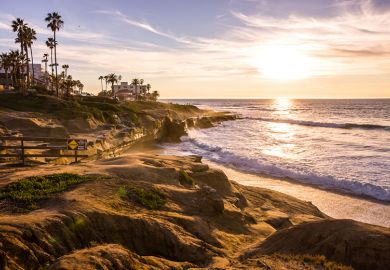Browse the full Young University Rankings 2017 results
When Pradeep Khosla was appointed chancellor of the University of California, San Diego in 2012, he thought that the institution, which was founded in 1960, was being “held back” by its short history and relatively small endowment.
“But the longer I’ve stayed here, the more I have come to realise and appreciate that lack of a long history is actually an advantage, especially in higher education,” he says.
“It’s good for every one of us to have a history, but to have a past that we cannot break away from is not good.”
Being unbound by tradition has given UC San Diego the liberty to innovate. For example, while the scholarly study of psychology dates back to ancient Greece, UC San Diego was the first institution to establish cognitive science as a discipline, launching the world’s first university department in the subject in 1986, Khosla says.
The university’s college system is also groundbreaking: each of its six colleges has a different theme, such as the environment or internationalisation, but all subject majors are available at every college.
This means that students can pick both a theme and a subject that they want to focus on during their degree, which promotes interdisciplinary study and aims to prepare them well for the workplace.
“The UC San Diego model from day one was built on education around issues rather than education around disciplines,” Khosla says.
It may then come as no surprise that UC San Diego leads a new Times Higher Education list of the world’s top “Golden Age” universities – the best 100 institutions that were founded between 1945 and 1966.
Like San Diego, the other universities in the table benefit from the combination of having had sufficient time to put down roots and grow strong while still being relatively young by world standards.
Nine other US universities make the list, including three others in the University of California system: Irvine (ninth; 1965), Santa Cruz (15th; 1965), and Riverside (joint 19th; 1954).
Roger L. Geiger, distinguished professor of higher education at Pennsylvania State University and author of The History of American Higher Education: Learning and Culture from the Founding to World War II , says that there are two factors for the expansion of US higher education after 1945: the “huge” increase in the college-age population and the rise in the proportion of people choosing to go to university.
“Back in the 1950s, about 20 per cent of high school graduates were going to college. By 1970, that was up to 40 per cent or more,” he says.
He adds that these trends likely developed out of the “growing prominence of higher education and its uses in society” as well as the “growth of the middle class”.
It helped that state governments invested “enormous amounts of money” to expand small colleges and private institutions into large universities.
The federal government, well aware of the key role that scientific research had played in the US war effort, also provided greater funding for research, says Roger Brown, emeritus professor in higher education policy at Liverpool Hope University. It also paid for former service personnel to go to university through the GI Bill, he notes.
But while higher education in the US expanded greatly in this period, the most-represented country in the “Golden Age” list is the UK, which takes almost a fifth of the top 100 places (19).
The majority of the UK’s representatives are “plate-glass universities” (the term reflects their modern architectural design) founded in the 1960s in the wake of the Robbins report.
Commissioned by the UK government, the report recommended the establishment of nine new universities (which led to the creation of the University of East Anglia and the University of York, for example) and the conversion of the 10 existing colleges of advanced technology into full universities (such as Aston University and the University of Bath).
The report also stated that university places “should be available for all those who are qualified by ability and attainment to pursue them and who wish to do so”.
Robert Anderson, professor emeritus in history at the University of Edinburgh, has written extensively about the history of British higher education. He says that like the US, the UK expansion owed much to the growing birth rate after the Second World War, as well as to an increase in the number of young people staying at secondary school to complete A levels, following the 1944 Education Act.
Much of the boom in student numbers is also down to a large rise in the number of women entering university, he continues, while there was also demand for more technical scientific education after the war.
“The Second World War proved how important science and research and technology were, and there was a feeling that [those areas] really had to be boosted, especially in the Cold War atmosphere,” he says, adding that Russia was then regarded as a “great scientific power” and a source of competition, along with the US, France and West Germany.
Australia experienced a similar expansion of higher education during this period.
Tamson Pietsch, fellow in the department of history at the University of Sydney, whose research focuses on the history of universities, says that Australia’s post-war universities such as La Trobe and Monash “came out of the same moment that produced the Sussexes and Warwicks” in the UK.
Overall, six Australian universities feature in the “Golden Age” list, led by the Australian National University in second place (1946).
Its vice-chancellor, Brian Schmidt, says that the institution was established in the aftermath of the Second World War to give Australia a “stronger research capacity”. It remains the only university in the country to have been set up by the national government.
“The founders wanted to develop the nation’s intellectual leaders and build an institution that, in the language of the day, would help ‘Australia align itself with the enlightened nations of the world’,” he says.
Meanwhile, in Germany, the Free University of Berlin (fifth in the table; founded in 1948) was created at a similar time but for very different reasons. Its establishment was in response to demands for a university free from political influence.
“In the early years after the Second World War, students and faculty studying and teaching at the University of Berlin, which was located in the Eastern sector of the divided city, united with politicians in a reaction to the repressive political influence on various individuals,” explains Peter-André Alt, the university’s rector.
“With great effort and assistance from the Western Allies, they founded a new university in Dahlem, a district in West Berlin.
“The guiding values of the new, politically free, university were truth, justice and liberty. These values, which guide the university’s research and teaching, continue to be of utmost importance today.”
Universities continued to be established throughout the world from the late 1960s to the mid-1980s, but the next major wave in higher education expansion began in the late 1980s.
Many technical colleges and colleges of advanced education in Australia were “absorbed” into existing universities, says Pietsch, while new universities were also established.
Similar moves occurred in the UK in 1992, when polytechnics were given university status.
At the same time, tuition fees were reintroduced in Australia, along with student loans, adds Pietsch, a move that the UK later copied in 1998.
“We’ve got to see those reforms in the late 1980s and early 1990s, both in Britain and Australia – I think they’re riding a very similar wave and, interestingly, both were introduced by Labour governments – as part of a deindustrialisation of the economy,” says Pietsch.
“There was a lot of talk at the time about training up a different kind of workforce for the nation that wouldn’t be as reliant on industry and agriculture in Australia. But there was also big pressure from families, from students, who wanted the benefit of a middle-class education. So in a way, it reflected the wealth of these countries as well.”
Liverpool Hope’s Brown adds that the 1990s expansion in the UK was helped along by a combination of employer demand, mainly in the public sector, and the secondary school reforms that led to students staying at school for longer.
The pre-millennial period was a time of significant expansion in higher education in Asia as well.
The list of the world’s best 50 “Generation Y” universities (founded between 1985 and 1999) features Hong Kong University of Science and Technology (1991), Nanyang Technological University (1991) and Pohang University of Science and Technology (1986) in the top three places.
Overall, 20 Asian universities make the top 50 list, including universities in India, Taiwan, Pakistan, Thailand and Turkey.
The continent is also home to some of the youngest universities in the world, according to the list of the best “Millennial” universities (founded from 2000 onwards), which features Tokyo Metropolitan University (13th; 2005), Malaysia’s Universiti Tunku Abdul Rahman (UTAR) (joint 14th; 2002), Saudi Arabia’s Alfaisal University (joint 18th; 2002) and Asia University, Taiwan (joint 18th; 2001).
Pietsch says that there is a tendency for China to take the limelight in discussions about the future of higher education, but East Asia is not the only region that has seen “exponential growth” in higher education in recent years.
“There’s been an explosion of universities in the Middle East as well, and a whole realm of private providers that call themselves universities and operate across all sorts of contexts, throughout Africa, Southeast Asia, but also in places like Australia and India,” she says.
Also featuring in the “Millennials” table are several European universities, many of them born out of mergers of established institutions.
For example, Finland’s Aalto University (fifth in the table) was created in 2010 by the merger of three universities: the Helsinki University of Technology, the Helsinki School of Economics and the University of Art and Design Helsinki.
The union was initiated by the heads of the three institutions, who proposed a new university “that would have an attractive future-oriented profile in emerging areas that would be relevant for society”, explains Ilkka Niemelä, Aalto’s provost.
But it was supported by the government, which was keen to “strengthen the innovative capacity of the country”.
Even with all that going for it, Niemelä admits that the competition for faculty and students, just like that to advance knowledge and create innovation, is intense.
“The established universities in the UK and the US are quite strong with their endowments, tuition fees and so on. And then there’s the huge development in Asia,” he says.
Will there be further higher education expansion in the future?
Regarding the US, Geiger says that it is difficult to envisage much growth without “major improvements in primary and secondary education”.
“In terms of the upper middle class, about everybody who can go [to university] does go,” he says. “In the lower middle class, it’s a little dicier – students have more financial difficulty, they tend to go part-time. And among the very poor students, the graduation rates are very low.”
In the UK, new legislation will allow private providers to award their own degrees, but Brown is sceptical about whether this will lead to expansion.
“I can’t really think of one positive factor that’s going to increase the demand for graduates,” he says, citing demographic trends, the attractiveness of apprenticeships, the expense of higher education and Britain’s exit from the European Union as factors that could reduce the numbers of students attending UK universities.
But Pietsch believes that expansion will occur whether or not there is a need.
“There is a perception that there is an imperative to shift the burden of education from the public purse to the private purse, which will have real consequences,” she says.
“One of them will be the emergence of new institutions. And in a way, that is also a return to the 19th century, [when there] were a host of other kinds of institutions that provided higher education and technical training. That’s what we’re seeing again – the proliferation of institutions of knowledge.”
Register to continue
Why register?
- Registration is free and only takes a moment
- Once registered, you can read 3 articles a month
- Sign up for our newsletter
Subscribe
Or subscribe for unlimited access to:
- Unlimited access to news, views, insights & reviews
- Digital editions
- Digital access to THE’s university and college rankings analysis
Already registered or a current subscriber?








